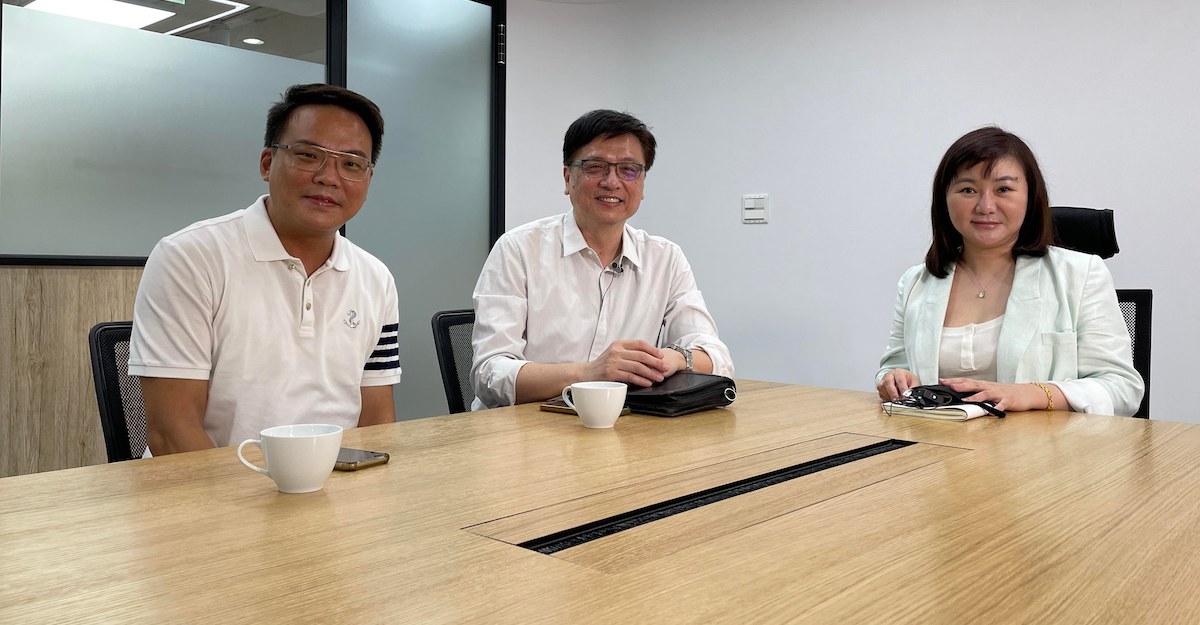AI is widely used in a range of industries, including well-known auto technologies such as autonomous driving, facial recognition, eye tracking, etc., all of which are changing the future of the auto industry and road traffic safety step by step. Moreover, AI can change the existing auto business model from manufacturing plants and retail channels. On the morning of September 27, the Auto Future editorial team visited the SIISR of the Commerce Development Research Institute in downtown Taipei and interviewed Director General Ms. Hui-Yi Fan for a comprehensive discussion on the use of AI in the auto industry beyond products.
 Ms. Hui-Yi Fan (Right), Director General of SIISR of the Commerce Development Research Institute, had an interview with Jeff Lee (Middle) and Seven Tseng (Left), editors of Auto Future.
Ms. Hui-Yi Fan (Right), Director General of SIISR of the Commerce Development Research Institute, had an interview with Jeff Lee (Middle) and Seven Tseng (Left), editors of Auto Future.
Ms. Fan began by discussing how the auto industry has been revolutionized since Tesla rang up the curtain on the era of EVs over a decade ago. From Tesla's creation of brand value that craves future dreams to new business opportunities for Taiwan's supply chains and new strategic technology alliances Taiwan automakers can form with Japanese manufacturers under the existing cooperative structure, she offered general insights. From the perspective of business operation, Ms. Fan believes that Tesla's direct sales e-commerce platform has truly altered the ecology of traditional auto sales. In addition to closely connecting automakers and consumers, Tesla collects data from consumers' use of cars to analyze big data databases and in turn, improves products and the efficiency of operations, deepens customer loyalty, and boosts the Company's performance. And AI plays a crucial role in this operational system.
In cases where the SIISR works with department stores retail, the concept of operations similar to Tesla's is applied to "precision marketing", using a predictive system to surmise the purchasing power of shoppers and what products they may be interested in based on their basic information for companies to draw up an action plan for merchandise display and marketing. The same logic can be applied to potential customers in the auto retail industry, except that buying a car is not like buying general merchandise. While many people might enter a department store just for some fun window shopping, most people have done their "homework" by asking friends and family and collecting information online when they enter an auto showroom. It is in fact a huge challenge for the salesperson to make predictions to carry out precision marketing. So instead of working on showroom visitors, auto companies need to start from the point of contact further at the front end on the Internet. When it comes to helping auto retailers (distribution channels) increase their value in the future auto era instead of being eliminated by Tesla's direct sales model, Ms. Fan figures that apart from tailored, high-quality services exclusively for customers, dealers should seek to collect data on prospects and submit the data to the brand's distributor for big data analysis before providing more practical action plans to the front-line dealership staff. The SIISR has a database of 300,000 people nationwide that can use AI algorithms to provide companies with effective solutions thru the process. This large database, gathering and accruing information about the daily routine of individuals in various age groups from all walks of life across the country for 10 years, classifies the nation's residents into 87 different types of life and collaborates with companies to develop countermeasures in three steps…
- The company's value proposition. Matching groups (there may be many) are identified in the process of comparing the attributes of the company's existing customers, and then a review is conducted to determine whether they match the subjects in the company's initial value proposition.
- UX/UI (user experience/interface) adjustment. This is critical to car sales. Whether it is a virtual or actual test drive, nuances in the convenience of ordering a car online, the layout of the screen where consumers select optional equipment, etc. often affect the consumer's decision to purchase a car.
- O2O strategy. For both online to offline and offline to online (strategy designed for companies to guide consumers to interact and make purchases online and offline), company needs to propose practices that meet the needs of target customer groups to induce their O2O consumer behaviors and in turn, enhance customer bonding and loyalty as well as cultivate the company's lifelong value to its customers.
In the evolution of the above steps, the SIISR assists companies in identifying the behavioral patterns as well as likes and dislikes of their target markets, and then accurately developing feasible plans to improve operations.
At the end of the interview, Ms. Fan mentioned some practical examples of cooperation with automakers. When a traffic accident occurs, AI technology can be used on the spot to provide photos of the damaged parts of the vehicle to the mechanic as the basis for determining the repairs (and of course, also as the basis for insurance claims payments later on). In addition, contextual dialogue is used to develop a chatbot provided by the automaker to the car owner. The chatbot can communicate with different language groups (for example, the wording of millennials is very different from that of people over 50 years old) without any discrepancies in semantic awareness during communication. This is particularly convenient and useful when automakers confirm warranties with car owners.